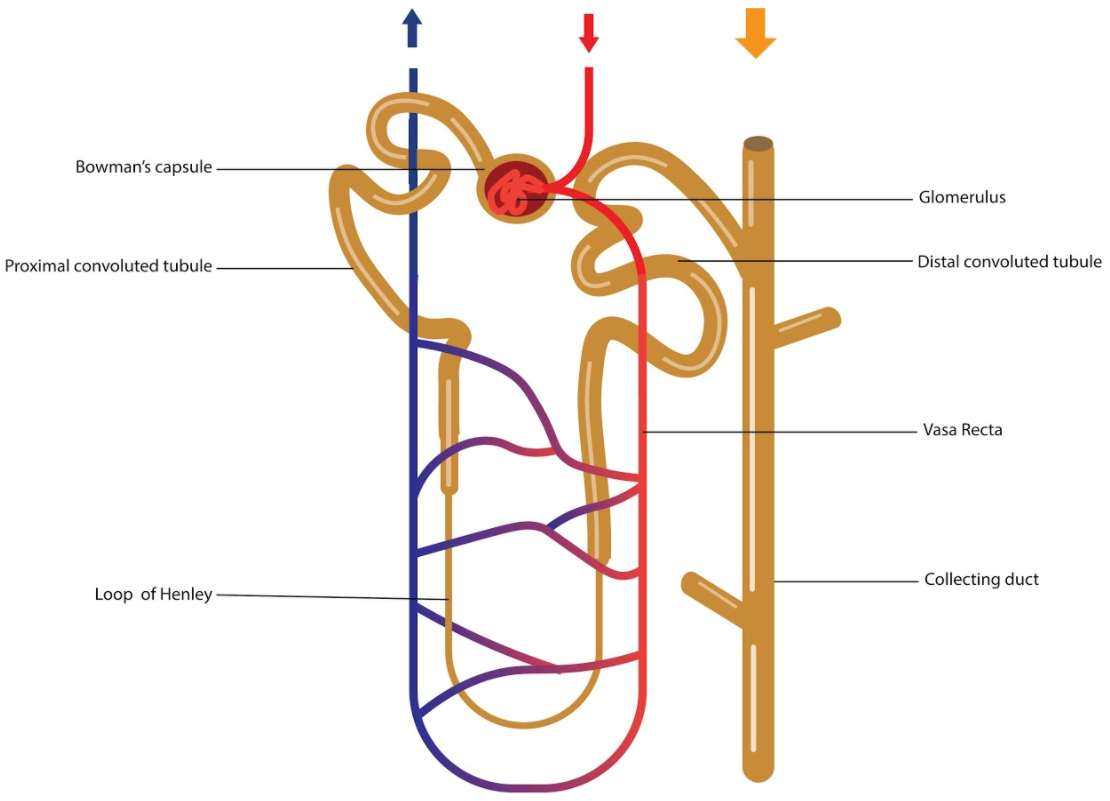
The two main parts of the nephron are
A) Bowman’s capsule and renal tubule
B) Glomerulus and renal tubule
C) Bowman’s capsule and glomerulus
D) The glomerulus and malpighian body
Answer
576.3k+ views
Hint: The main parts of the nephron consists of a bundle of capillaries and various tubules which help in the filtration and reabsorption.
Complete Answer:
The nephron is structural and the functional unit of the kidney. It is composed of a renal corpuscle and renal tubule. The renal corpuscle consists of a network of blood capillaries called the glomerulus, which is present inside the Bowman’s capsule while the renal tubule originates from the capsule.
Additional information:
1) Nephron helps in the absorption of water, glucose, and other substances.
2) There are around 1-1.5 million nephrons present in each kidney.
3) The Bowman’s capsule has capillaries that help in the process of filtration and form renal corpuscle.
4) The blood undergoes filtration due to three layers which follow the renal corpuscle; the endothelial cells, basement membrane, and the podocytes of the capillary walls.
5) The renal tubule is divided into various parts: proximal convoluted tubule, a loop of Henle, distal convoluted tubule, connecting tubule, and the collecting ducts.
6) The renal tubule processes and carries away the filtered fluid from the renal corpuscle.
7) Then the filtrate will continue to collect in the collecting duct.
8) In 1942, William Bowman, a famous English surgeon, and anatomist discovered the nephrons’ true nature.

So, the correct answer is ‘Bowman’s capsule and renal tubule.’
Note: Malphigian body is made up of both the glomerulus and the Bowman’s capsule. They are part of the filtration system through which nonprotein components of blood plasma enters the tubules for urinary excretion. They are quite small in size, around 0.2 mm in diameter. The malpighian body is also known as the renal corpuscle.
Complete Answer:
The nephron is structural and the functional unit of the kidney. It is composed of a renal corpuscle and renal tubule. The renal corpuscle consists of a network of blood capillaries called the glomerulus, which is present inside the Bowman’s capsule while the renal tubule originates from the capsule.
Additional information:
1) Nephron helps in the absorption of water, glucose, and other substances.
2) There are around 1-1.5 million nephrons present in each kidney.
3) The Bowman’s capsule has capillaries that help in the process of filtration and form renal corpuscle.
4) The blood undergoes filtration due to three layers which follow the renal corpuscle; the endothelial cells, basement membrane, and the podocytes of the capillary walls.
5) The renal tubule is divided into various parts: proximal convoluted tubule, a loop of Henle, distal convoluted tubule, connecting tubule, and the collecting ducts.
6) The renal tubule processes and carries away the filtered fluid from the renal corpuscle.
7) Then the filtrate will continue to collect in the collecting duct.
8) In 1942, William Bowman, a famous English surgeon, and anatomist discovered the nephrons’ true nature.

So, the correct answer is ‘Bowman’s capsule and renal tubule.’
Note: Malphigian body is made up of both the glomerulus and the Bowman’s capsule. They are part of the filtration system through which nonprotein components of blood plasma enters the tubules for urinary excretion. They are quite small in size, around 0.2 mm in diameter. The malpighian body is also known as the renal corpuscle.
Recently Updated Pages
Why is there a time difference of about 5 hours between class 10 social science CBSE

In cricket, what is a "pink ball" primarily used for?

In cricket, what is the "new ball" phase?

In cricket, what is a "death over"?

What is the "Powerplay" in T20 cricket?

In cricket, what is a "super over"?

Trending doubts
Who was the first woman to receive Bharat Ratna?

Write a letter to the principal requesting him to grant class 10 english CBSE

What is the median of the first 10 natural numbers class 10 maths CBSE

The Equation xxx + 2 is Satisfied when x is Equal to Class 10 Maths

Who Won 36 Oscar Awards? Record Holder Revealed

Discuss the main reasons for poverty in India




